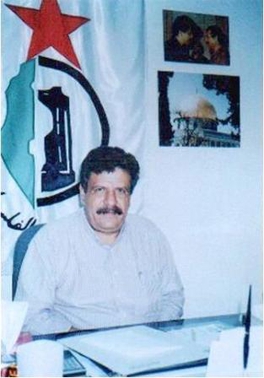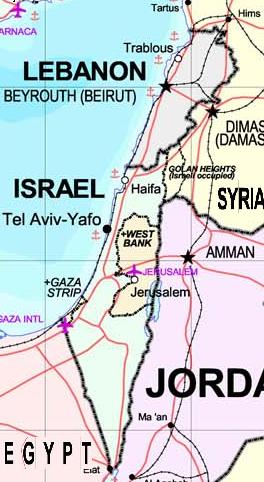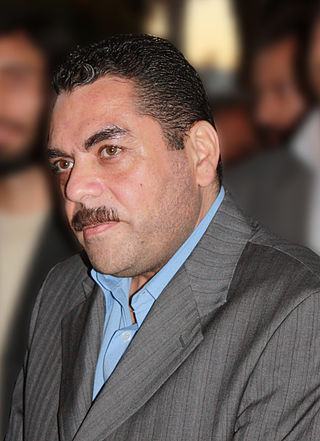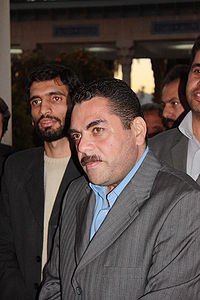
Muhammad Zaidan, also known as Abu AbbasAH-boo ə-BAHSS or Muhammad Abbas, was the founder and a leader of the Palestine Liberation Front (PLF) Organization.

Ehud "Udi" Goldwasser was an Israeli soldier who was abducted in Israel by Hezbollah along with Eldad Regev on 12 July 2006, sparking the 2006 Lebanon War. His rank was first sergeant.

Eldad Regev was an Israeli soldier abducted by Hezbollah fighters along with Ehud Goldwasser on 12 July 2006 in Israel near the Lebanese border, sparking the 2006 Lebanon War. His rank was Sergeant First Class.
This is a timeline of events related to the 2006 Lebanon War.

The Israeli–Lebanese conflict, or the South Lebanon conflict, is a series of military clashes involving Israel, Lebanon and Syria, the Palestine Liberation Organization, as well as various militias acting from within Lebanon. The conflict peaked in the 1980s, during the Lebanese Civil War, and has abated since.

The South Lebanon conflict, designated by Israel as the Security Zone in Lebanon Campaign, was a protracted armed conflict that took place in southern Lebanon from 1985 to 2000. It saw fighting between Israel and the Catholic Christian-dominated South Lebanon Army (SLA) against Hezbollah-led Shia Muslim and Left-wing guerillas within the Israeli-occupied "Security Zone"; the SLA had military and logistical support from the Israel Defense Forces over the course of the conflict and operated under the jurisdiction of the Israeli-backed South Lebanon provisional administration, which succeeded the earlier Israeli-backed State of Free Lebanon. It can also refer to the continuation of the earlier conflict in this region involving the growing Palestinian insurgency in South Lebanon against Israel following the expulsion of the Palestine Liberation Organization (PLO) from Jordan after Black September. Historical tensions between Palestinian refugees and Lebanese factions contributed another layer to the Lebanese Civil War (1975–1990), which saw the Maronite-led Lebanese Front and the Shia Amal Movement at war with the PLO. Hence, the South Lebanon conflict can partly be seen as an extension of the civil war that ended in 1990.

The 2006 Hezbollah cross-border raid was a cross-border attack carried out by Lebanon-based Hezbollah militants on an Israeli military patrol on 12 July 2006 on Israeli territory.
Lebanese prisoners in Israel have been a source of contention between Lebanon and Israel and were an issue in the 2006 Lebanon War. The number of such detainees is disputed. According to the Lebanese paramilitary and political party Hezbollah, there are two Lebanese citizens in Israeli prisons, but Israel denies holding them. Hezbollah had demanded the release of Lebanese prisoners as condition for releasing Israeli reservists Ehud Goldwasser and Eldad Regev, captured in the Hezbollah raid which started the 2006 Lebanon War. On July 16, 2008, the Israel Prison Service released five Lebanese prisoners in exchange for the remains of Goldwasser and Regev.

The Rosh HaNikra Crossing also known as Ras Al Naqoura Crossing is an international border crossing between Naqoura, Lebanon and Rosh HaNikra, Israel. The terminal is operated solely by the United Nations Interim Force in Lebanon and the Israel Defense Forces. The passage of regular tourists/visitors is forbidden.

The 2008 Israel–Hezbollah prisoner exchange took place on 16 July 2008 when Hezbollah transferred the coffins of two Israeli soldiers in exchange for 5 Lebanese militants held by Israel as well as the bodies of 199 militants captured in Lebanon or Israel.

The 2000 Hezbollah cross-border raid occurred at the boundary between Lebanon and the Golan Heights on October 7. Hezbollah militants captured three Israeli soldiers while they were patrolling the security fence, and subsequently took them into Lebanon. While the time and circumstances of the three soldiers' deaths remain unknown, their bodies were returned to Israel in a prisoner exchange on 29 January 2004.

Samir Kuntar was a Lebanese Druze member of the Palestine Liberation Front and Hezbollah. He was convicted of terrorism and murder by an Israeli court. After his release from prison as part of the 2008 Israel–Hezbollah prisoner exchange, he received Syria's highest medal, was honored by Iranian President Mahmoud Ahmadinejad, and was designated a Specially Designated Global Terrorist by the US government.
This article outlines events which occurred in Israel in the year 1979.
Events in the year 2008 in the Palestinian territories.

The Palestinian insurgency in South Lebanon was a conflict initiated by Palestinian militants based in South Lebanon upon Israel from 1968 and upon Christian Lebanese factions from the mid-1970s, which evolved into the wider Lebanese Civil War in 1975 and lasted until the expulsion of the Palestine Liberation Organization from Lebanon in the 1982 Lebanon War. Although the PFLP-GC and some other Palestinian factions continued low-level military activities on Lebanese soil, after 1982 the conflict is considered to have faded in favor of local inter-Lebanese Mountain War and the Israel–Hezbollah conflict.
Events in the year 2015 in Israel.

As a response to an Israeli attack against a military convoy comprising Hezbollah and Iranian officers on January 18, 2015 at Quneitra in southern Syria, the Lebanese Hezbollah group launched an ambush on January 28 against an Israeli military convoy in the Israeli-occupied Shebaa Farms, firing anti-tank missiles against two Israeli Humvees patrolling the border, destroying the two Humvees and killing 2 and wounding 7 Israeli soldiers, according to Israeli military. The number of Israeli casualties was 15 according to a report by Al Mayadeen television station. A Spanish UN peacekeeper was also killed by Israeli fire during consequent fire exchanges in the area, with Israel firing artillery and Hezbollah responding by mortar shells. The conflict ended later the same day after UNIFIL mediation.

Jihad Mughniyah was a prominent member of the Lebanese Shia militant group Hezbollah and the son of Imad Mugniyah. He was killed in 2015 in the Mazraat Amal incident, an airstrike attributed to Israel.
The Iran–Israel conflict during the Syrian civil war refers to the Iranian–Israeli standoff in and around Syria during the Syrian conflict. With increasing Iranian involvement in Syria from 2011 onwards, the conflict shifted from a proxy war into a direct confrontation by early 2018.















